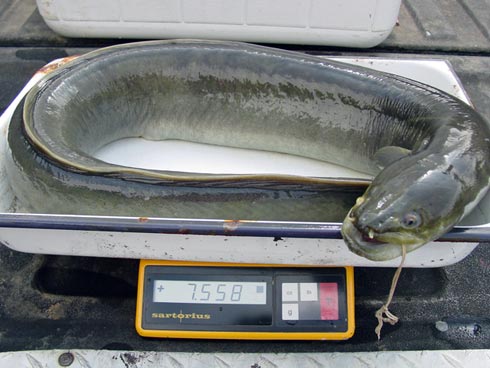SCIENTIFIC NAME:
Anguilla rostrata
CHARACTERISTICS:
The American eel has a snakelike body covered with tiny embedded scales (and a thick slime layer). On the head are paired eyes and nostrils. The mouth has movable jaws with many sharp teeth. The dorsal, caudal and anal fins are fused into one long fin extending around the posterior of the body. The upper half of the body is olive green to brown, grading from pale yellow to white on the venter. Eels resemble lampreys, but the former are distinguished by their hinged jaws with well-developed teeth, paired eyes and nostrils, paired pectoral fins, and single gill slit on each side of the head. Pelvic fins are absent on this species. See Lesueur (1817a) for original description.
ADULT SIZE:
2.9 to 4.9 ft (0.9 to 1.4 m).
STATE RECORD:
a list of the State Record Freshwater Fish.
DISTRIBUTION:
Recent records of American eels in the Tennessee River of Alabama are rare. Lee (1978b) included one record from a southern tributary. Feeman (1987) reported a specimen from the Paint Rock River downstream of the junction of Estill Fork and Hurricane Creek in Madison County. In 1993, we collected and released American eels at two stations in the drainage, one in Estill Fork of the Paint Rock River and another in the lower reaches of Cypress Creek in Lauderdale County. American eels have been collected from every river system in the Mobile basin as well as from several coastal drainages in southeastern Alabama. Although eels are known from downstream, none were collected in the Escatawpa River system in Alabama, probably due to limited boat access and insufficient sampling with proper gear. Inland distributions of American eels and several other fish species may have declined in recent years because of their inability to navigate over or through high-lift locks and dams. The greatest eel concentrations occur in the southern half of the state, particularly in the Mobile Delta. Angler reports supplemented by sampling efforts indicate a progressive decline in abundance with each upstream dam.
HABITAT AND BIOLOGY:
Most individuals of this species have been collected around aquatic vegetation and from undercut banks in rivers, reservoirs, and large streams. American eels are common in rocky shoals of tailwater areas below Jordan and Thurlow dams on the Coosa and Tallapoosa rivers, respectively. During our 1992 and 1993 sampling efforts in the Mobile Delta, we saw many American eels of all sizes around beds of aquatic vegetation and along undercut mud banks. Wenner and Musick (1975) reports that American eels feed on small fishes, crayfishes, and insects in fresh water and on small crustaceans, bivalves, and polychaete worms in coastal areas.
Called a catadromous species, eels spend six or seven years of their lives in fresh water but move out to sea to breed. As they reach adult size in the fresh waters of eastern North America and are stimulated to spawn, they begin a long, one-way migration that takes them downstream into the Gulf of America, around the tip of Florida, and into the Atlantic Ocean. Actual spawning occurs sometime during mid- to late winter but has never been observed. Opinions differ as to the exact spawning area, but judging from field studies, ichthyologists speculate that it is near the Sargasso Sea and the island of Bermuda. Robins et al. (1979) report that a possibly gravid female American eel was photographed off the Bermuda Islands at a depth of about 6,000 feet. The European eel, Anguilla anguilla, resembles the American eel and is believed to spawn in the same general area, perhaps at a different time of year.
After the eels spawn, they die. The pelagic eggs float in the water column until they hatch into what are called leptocephalus larvae. The aimless voyage of young eels lasts from 12 to 18 months, during which time they undergo successive physical changes to become "glass eels" and finally "elvers." Most elvers reach the estuaries along the Atlantic Coast and in winter and spring begin ascending the major rivers to begin their freshwater existence. Some, however, continue their voyage into the Gulf of America and are delivered (via the Gulf Stream and nearshore currents) to the Choctawhatchee Bay system and other coastal areas east of the Mississippi River, where they migrate inland during winter and spring. Vladykov (1971) suggests that American elvers may return to the same rivers that their parents occupied.
ORIGINAL DESCRIPTION:
Lesueur described the American eel in 1817.
ETYMOLOGY:
Anguilla means eel.
Rostrata means long nose.
The copyrighted information above is from Fishes of Alabama and the Mobile Basin.









